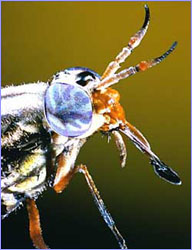|

|

|
|
|
 Deer flies can carry tularemia and cause natural
cases of human infection.
Deer flies can carry tularemia and cause natural
cases of human infection.
|
Agents of Bioterror
Tularemia
incubation period |
symptoms |
how it would spread |
treatment |
vaccine
The agent that causes tularemia,
Francisella tularensis, is one of the most infectious
bacteria known: inhaling as few as ten microscopic germs can
trigger disease. A World Health Organization committee
estimated that if 110 pounds of a virulent strain of the
bacteria were sprayed over a city of five million, it could
incapacitate 250,000 people and kill 19,000. Respiratory
failure or shock would cause most fatalities.
During World War II, both the Japanese and U.S. militaries
researched tularemia. In the 1990s, the Soviet Union
developed antibiotic- and vaccine-resistant strains.
Tularemia occurs naturally in small mammals such as mice,
squirrels, and rabbits. Human infection, which is rare, can
result from insect bites or handling infected animals. It is
possible that infected flies, ticks, or mosquitoes could
intentionally be released as weapons, but direct spraying of
the bacteria is thought to be a more likely threat.
Incubation period before symptoms
1-14 days. Following a terrorist attack, cases would likely
be reported in 3-5 days.
Symptoms
Various forms of the disease all begin with the sudden onset
of flu-like symptoms:
- fever, chills, headache, cough, and lethargy
Additional symptoms depend on the form but include:
- swollen and sore lymph nodes
- skin ulcers
- red and sore eyes
- abdominal pain, diarrhea, and vomiting
- pneumonia
How it would be spread
Aerosol or food. Human-to-human transmission has not been
documented.
Treatment
Early antibiotic therapy is effective, and if started within
24 hours of exposure, may prevent disease. A variety of
antibiotics can be used, although some antibiotics may be
powerless against strains genetically engineered to be
resistant.
Vaccine
No vaccine is available for the general public. The U.S.
Food and Drug Administration is investigating a vaccine that
is now available for high-risk lab workers.
Chart of the 8 agents
Photo: Photo Researchers
History of Biowarfare
|
Future Germ Defenses
Interviews with Biowarriors
|
Global Guide to Bioweapons
|
Making Vaccines
Resources
|
Teacher's Guide
|
Transcript
|
Site Map
|
Bioterror Home
Search |
Site Map
|
Previously Featured
|
Schedule
|
Feedback |
Teachers |
Shop
Join Us/E-Mail
| About NOVA |
Editor's Picks
|
Watch NOVAs online
|
To print
PBS Online |
NOVA Online |
WGBH
©
| Updated November 2001
|
|
|
|